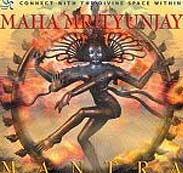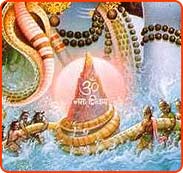Ganga Comes Down to Earth
A legend from the Ramayana speaks of King Bhagirath who once meditated before Lord Brahma for a thousand years for the salvation of the souls of his ancestors. Pleased with his devotion Brahma granted him a wish. He requested the Lord to send the river Ganges down to earth from heaven so that she could flow over his ancestors' ashes and wash their curse away and allow them to go to heaven. Brahma granted his wish but asked him to pray to Shiva, for he alone could support the weight of her descent. Accordingly he prayed to Shiva and he allowed the Ganges to descend on his head, and after meandering through his thick matted locks, the holy river reached the earth. This story is re-enacted by bathing the 'linga'.
The Tiger & the Leaves
Once a hunter while chasing a deer wandered into a dense forest and found himself on the banks of river Kolidum when he heard the growl of a tiger. To protect himself from the beast he climbed up a tree nearby. The tiger pitched itself on the ground below the tree fostering no intention to leave. The hunter stayed up in the tree all night and to keep himself from falling asleep, he gently plucked one leaf after another from the tree and threw it down. Under the tree was a Shiva Linga and the tree blessedly turned out to be a bilva tree. Unknowingly the man had pleased the deity with bilva leaves. At sunrise, the hunter looked down to find the tiger gone, and in its place stood Lord Shiva. He prostrated before the Lord and attained salvation from the cycle of birth and death.
Why Shiva is Worshipped in His Phallic Form
According to another legend, once Brahma and Vishnu, two other deities of the holy Trinity, had an argument as to their supremacy. Brahma being the Creator declared himself to be more revered, while Vishnu, the Preserver, pronounced that he commanded more respect.Just then a colossal 'lingam', known as Jyotirlinga, blanketed in flames, appeared before them. Both Brahma and Vishnu were awestruck by its rapidly increasing size. They forgot their quarrel and decided to determine its size. Vishnu assuming the form of a boar went to the netherworld and Brahma as a swan flew to the skies. But both of them failed to accomplish the self-assumed tasks. Then, Shiva appeared out of the 'lingam' and stated that he was the progenitor of them both and that henceforth he should be worshiped in his phallic form, the 'lingam', and not in his anthropomorphic form.
 The Maha Mrityunjay Mantra or Lord Shiva Mantra is considered extremely powerful and significant by the Hindus. Also known as the Moksha Mantra of Lord Shiva, chanting of Maha Mrityunjaya Mantra is said to create divine vibrations that heals. Devotees of Lord Shiva further believe that Maha Mrityunjay evokes the Shiva within human beings and removes the fear of death, liberating one from the cycle of death and rebirth.
The Maha Mrityunjay Mantra or Lord Shiva Mantra is considered extremely powerful and significant by the Hindus. Also known as the Moksha Mantra of Lord Shiva, chanting of Maha Mrityunjaya Mantra is said to create divine vibrations that heals. Devotees of Lord Shiva further believe that Maha Mrityunjay evokes the Shiva within human beings and removes the fear of death, liberating one from the cycle of death and rebirth. Significance of Maha Mrityunjaya Mantra
Devotees strongly believe that proper recitation of the Maha Mrityunjaya rejuvenates, bestows health, wealth, long life, peace, prosperity and contentment. It is said that chanting of Shiva Mantra generates divine vibrations that ward off all the negative and evil forces and creates a powerful protective shield. Besides, it is said to protect the one who chants against accidents and misfortunes of every kind. Recitation of the mantra creates vibration that pulsates through every cell, every molecule of human body and tears away the veil of ignorance. Hindus believe that recitation of the mantra ignites a fire within that consumes all negativity and purifies entire system. It is also said to have a strong healing power and can cure diseases declared incurable even by the doctors. Many believe Maha Mrityunjay Mantra to be a mantra that can conquer death and connect human beings to their own inner divinity.
The Maha Mrityunjaya Mantra
The following Maha Mrityunjay Mantra has been taken from the Sukla Yajurveda Samhita III. 60. The Mantra is addressed to Lord Shiva and is a centuries old technique of connecting one to pure consciousness and bliss.
Om Tryambhakam Yajamahe
Sugandhim Pushtivardhanam |
Urvarukamiva Bandhanan
Mrityor Mukshiya Maamritat ||
Meaning:
Om. We worship The Three-Eyed Lord Shiva who is fragrant and who increasingly nourishes the devotees. Worshipping him may we be liberated from death for the sake of immortality just as the ripe cucumber easily separates itself from the binding stalk.
Explanation:
The mantra is a prayer to Lord Shiva who is addressed as Sankara and Trayambaka. Sankara is sana (blessings) and Kara (the Giver). Trayambaka is the three eyed one (where the third eye signifies the giver of knowledge, which destroys ignorance and releases us from the cycle of death and rebirth).
Best Time to Chant
Chanting the Maha Mrityunjaya Mantra with sincerity, faith and devotion in Bramha Muhurata is very beneficial. But one can also do Maha Mrityunjaya japa anytime in a pure environment with great benefit and discover the happiness that's already within.

 This very popular Shivaratri legend from Puranas explains why people stay awake all night on Shivaratri. Besides, it also tells us why Lord Shiva is also known as Neelakantha.
This very popular Shivaratri legend from Puranas explains why people stay awake all night on Shivaratri. Besides, it also tells us why Lord Shiva is also known as Neelakantha.